Storing lettuce leaves properly can be a bit tricky, as they tend to wilt and spoil quickly. However, with the right techniques and storage methods, you can keep your lettuce leaves fresh and crisp for several days. In this article, I will share some tips on how to store lettuce leaves to extend their shelf life and prevent waste.
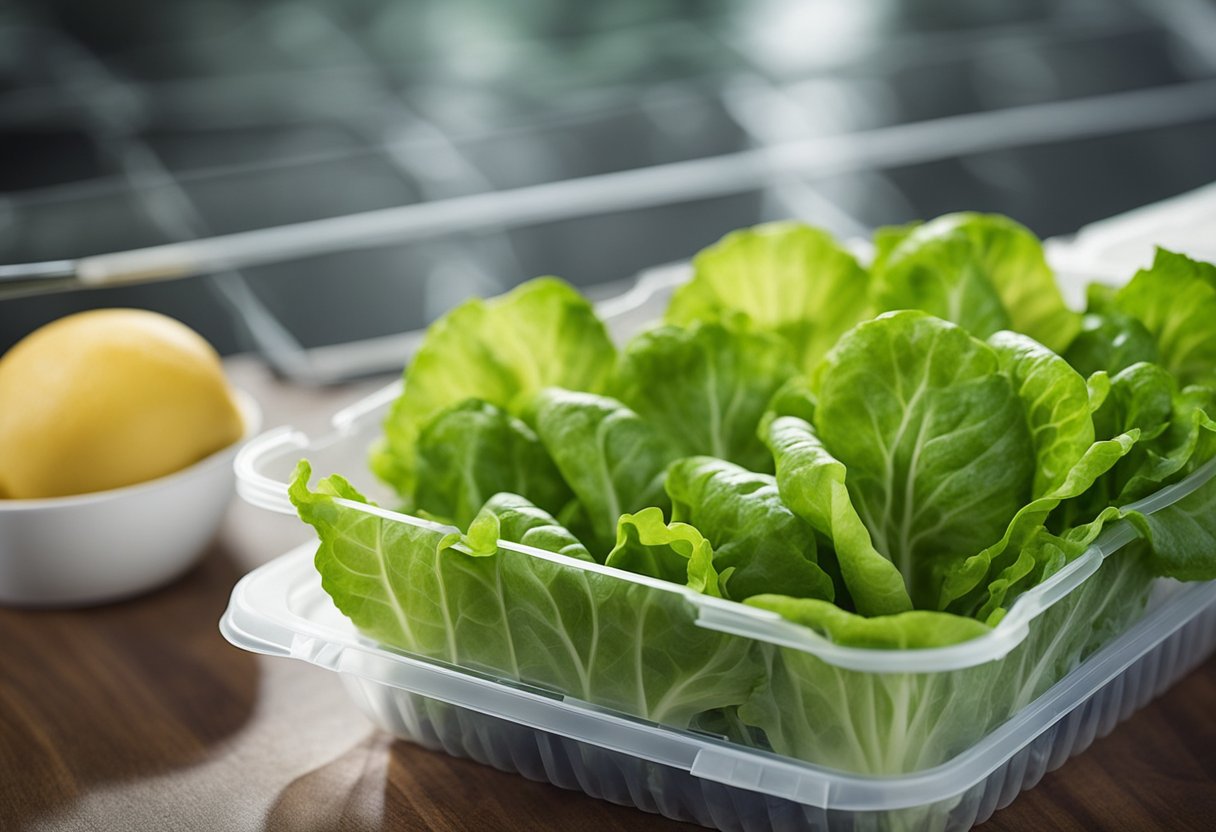
When it comes to storing lettuce leaves, the first step is to select the right lettuce. Choose fresh, crisp leaves that are free from any signs of damage or wilting. Once you have selected your lettuce, it’s important to prepare it properly before storage. This involves washing the leaves thoroughly to remove any dirt or debris, and drying them completely to prevent excess moisture.
To store lettuce leaves, you need to create the optimal storage conditions. This includes maintaining the right temperature and humidity levels, as well as choosing the right container and wrapping options. In the next section, I will discuss these factors in more detail and provide some useful tips to help you store your lettuce leaves effectively.
Key Takeaways
- Choosing fresh, crisp lettuce leaves is key to successful storage.
- Preparing lettuce leaves by washing and drying them is crucial to prevent spoilage.
- Optimal storage conditions, including temperature, humidity, container, and wrapping options, can help extend the shelf life of lettuce leaves.
Selecting Lettuce for Storage
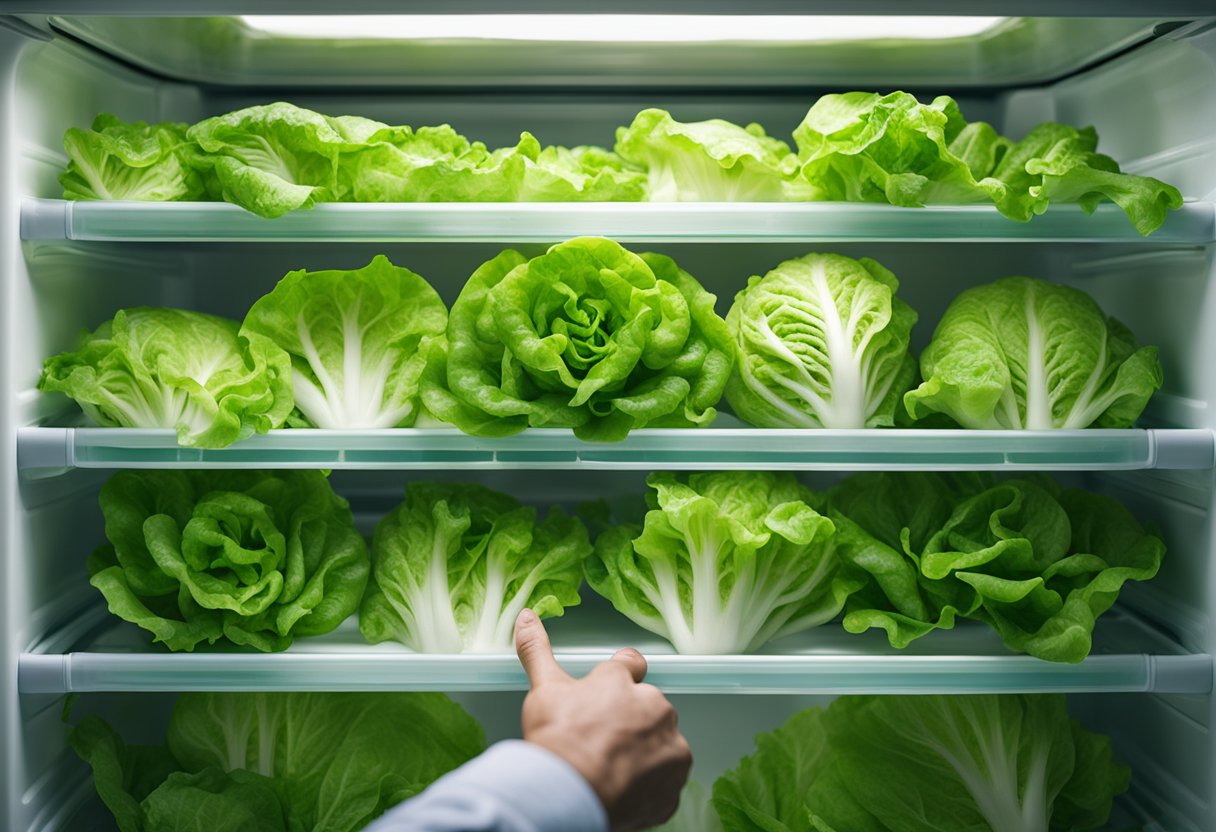
When it comes to storing lettuce, selecting the right type of lettuce is crucial. Here are some things to consider when choosing lettuce for storage:
Types of Lettuce
Different types of lettuce have different textures and water content, which can affect how long they stay fresh. Crisphead and romaine lettuces have thicker leaves that hold up longer than other varieties. Butterhead and loose-leaf lettuces are more delicate and can only be stored for up to five days. If you’re planning to store lettuce for longer periods, choose crisp lettuces such as romaine or green leaf that have fewer watery parts so that they don’t become soggy quickly.
Freshness Indicators
When selecting your lettuce, make sure you pick fresh-looking leaves that are crisp and free of any browning or wilting. Check the stem ends of the lettuce leaves to ensure they are not slimy or brown, which is a sign of decay. Also, avoid buying lettuce that has been pre-cut and packaged, as it will not last as long as whole heads of lettuce.
It’s important to note that lettuce is a perishable item, and even with proper storage, it will eventually start to wilt and lose its crispness. Therefore, it’s best to buy only as much lettuce as you need and to use it within a few days of purchase. By selecting the right type of lettuce and checking for freshness indicators, you can ensure that your lettuce stays fresh and crisp for as long as possible.
Pre-Storage Preparation
Before storing lettuce leaves, it is important to prepare them properly. Here are some pre-storage procedures that you should follow:
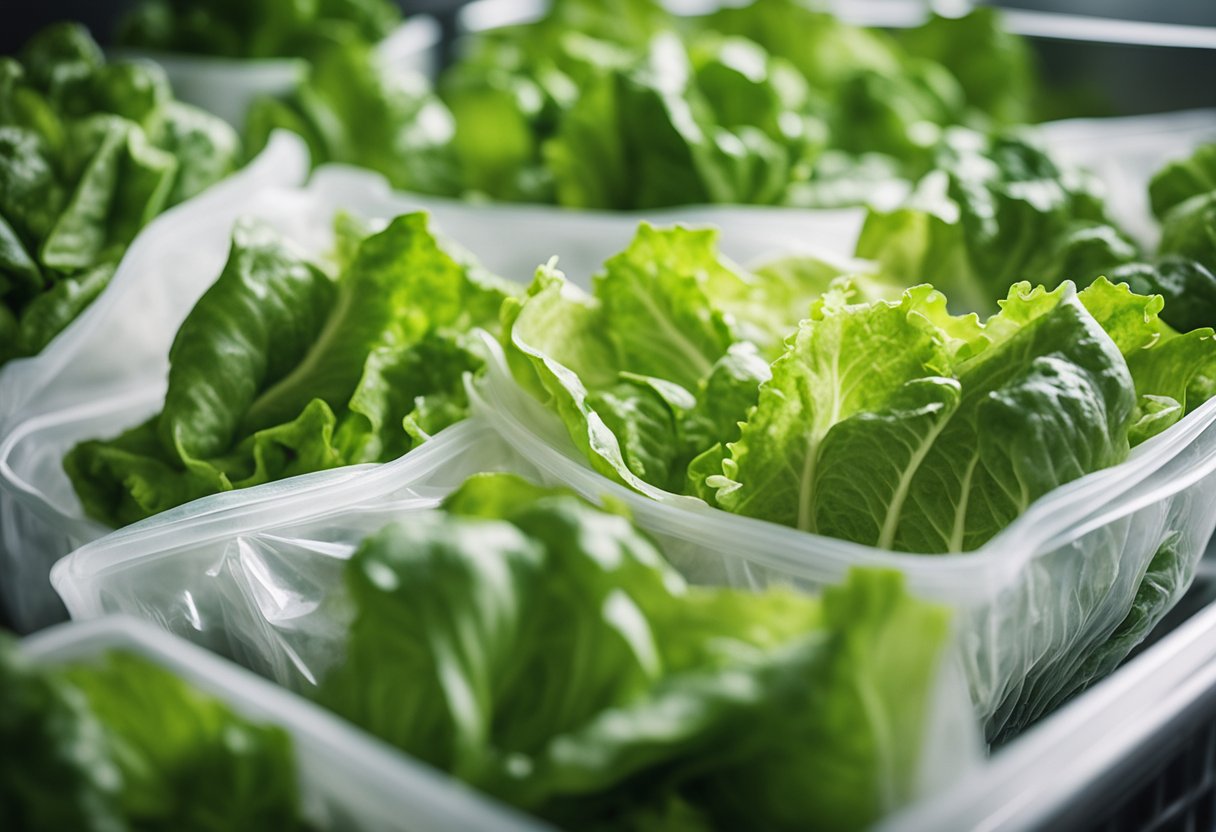
Cleaning Procedures
The first step in pre-storage preparation is to clean the lettuce leaves properly. To clean the leaves, fill a large bowl with cold water and add a tablespoon of vinegar. Then, place the lettuce leaves in the bowl and swish them around gently. This will help to remove any dirt or debris that may be stuck on the leaves. After cleaning the leaves, rinse them thoroughly with cold water to remove any remaining dirt or vinegar.
Drying Techniques
Once the lettuce leaves are clean, it is important to dry them thoroughly before storing them. Excess moisture can cause the leaves to wilt and spoil quickly. There are several ways to dry lettuce leaves, including:
- Using a salad spinner: A salad spinner is a handy tool that can be used to quickly and easily dry lettuce leaves. Simply place the leaves in the basket and spin them until they are dry.
- Using paper towels: Another way to dry lettuce leaves is to place them on a clean kitchen towel or paper towels. Gently pat the leaves dry with another towel or paper towels until they are completely dry.
- Air-drying: If you have the time, you can also air-dry lettuce leaves by placing them on a clean kitchen towel and leaving them to dry for a few hours.
By following these pre-storage procedures, you can ensure that your lettuce leaves are clean and dry before storing them. This will help to extend their shelf life and keep them fresh for longer.
Optimal Storage Conditions
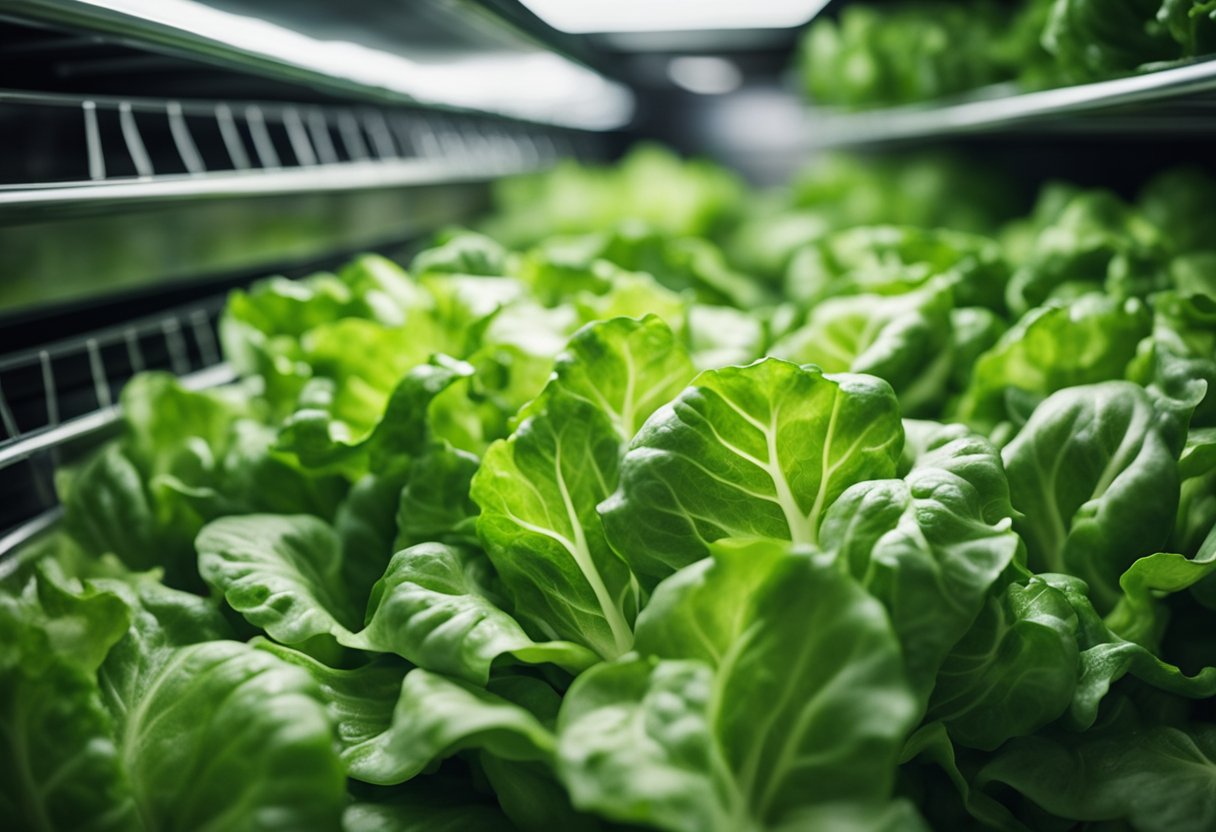
When it comes to storing lettuce, there are two main factors to consider: temperature and humidity. Proper temperature control and humidity management are crucial in keeping the lettuce fresh for an extended period.
Temperature Control
Lettuce is a delicate vegetable that is sensitive to temperature changes. It is essential to store lettuce at a cool temperature to prevent it from wilting or turning brown. The ideal temperature range for storing lettuce is between 32°F to 40°F (0°C to 4°C).
It would be best to store lettuce in the crisper drawer of the refrigerator, which is designed to maintain a temperature range of 32°F to 40°F. If you don’t have a crisper drawer, you can store lettuce in a plastic bag or airtight container and place it in the fridge.
However, it’s crucial not to freeze lettuce as it can cause the leaves to become mushy and lose their texture.
Humidity Management
Lettuce is also sensitive to humidity, and it’s essential to keep it in a moist environment to prevent it from drying out. High humidity levels can cause the lettuce to rot, while low humidity levels can cause it to wilt.
To maintain optimal humidity levels, wrap the lettuce in a damp paper towel or cloth before storing it in the fridge. The damp towel will help to keep the lettuce moist and fresh for an extended period.
It’s also important to avoid storing lettuce with fruits that produce ethylene gas, such as apples and bananas. Ethylene gas can cause the lettuce to ripen and spoil quickly.
By following these optimal storage conditions, you can keep your lettuce fresh and crispy for up to two weeks.
Also Read | 10 Varieties of Yellow Perennial Flowers: A Comprehensive Guide
Container and Wrapping Options
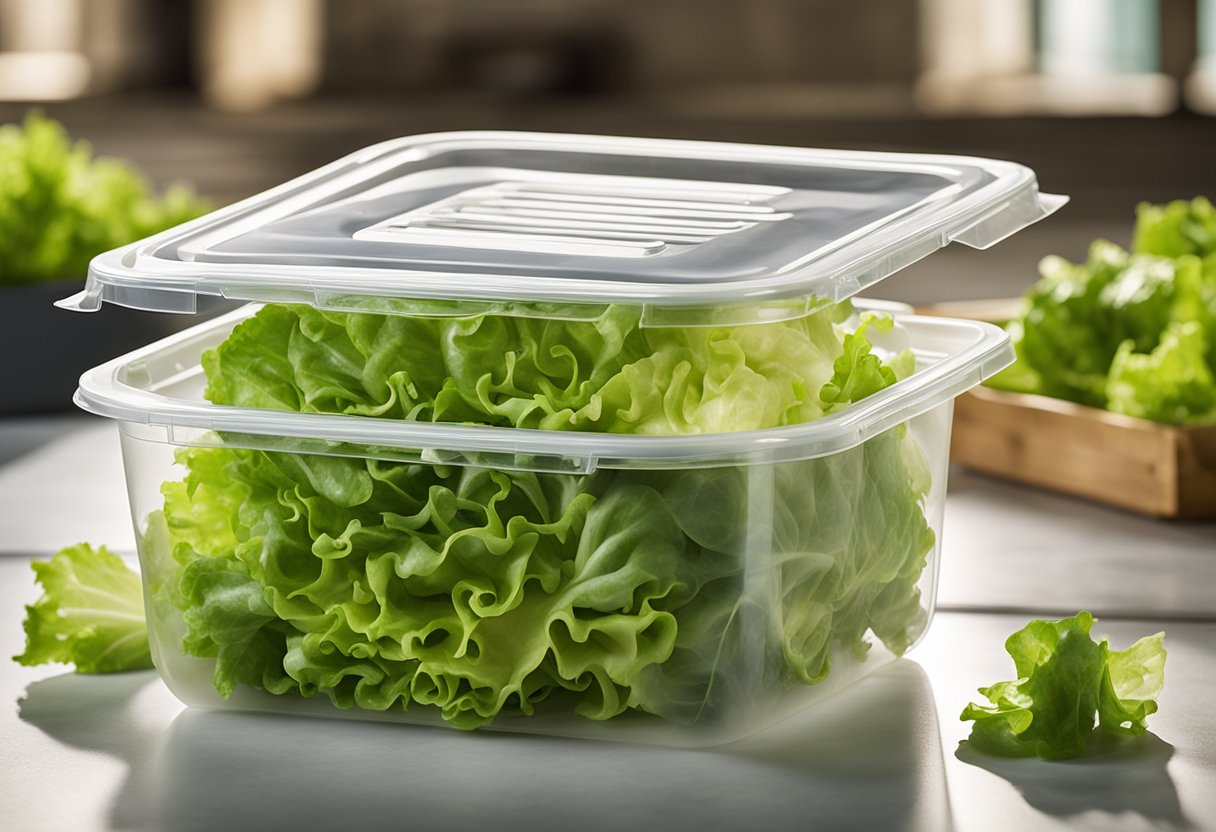
When it comes to storing lettuce leaves, choosing the right container or wrapping is crucial to keep them fresh for longer. Here are two options you can consider:
Airtight Containers
Airtight containers are ideal for storing lettuce leaves as they help prevent moisture and air from getting in, which can cause the leaves to wilt and spoil quickly. You can use plastic containers with tight-fitting lids or glass containers with airtight seals. Make sure to choose a container that is large enough to hold the lettuce leaves without overcrowding them.
To store the lettuce, wash and dry the leaves thoroughly, then place them in the container, making sure not to pack them too tightly. Seal the container and store it in the refrigerator’s crisper drawer. The lettuce should last for up to a week when stored in an airtight container.
Breathable Wraps
Breathable wraps are another option for storing lettuce leaves, especially if you don’t have an airtight container. These wraps allow air to circulate around the leaves, preventing moisture from building up and causing them to wilt.
You can use paper towels, dish towels, or reusable cloth wraps to store the lettuce leaves. After washing and drying the leaves, wrap them loosely in the towel or cloth, making sure not to squeeze them too tightly. Then, place the wrapped lettuce in a plastic bag and store it in the refrigerator’s crisper drawer. The lettuce should last for up to three days when stored in a breathable wrap.
Choosing the right container or wrapping can make a significant difference in the longevity of your lettuce leaves. Consider the options above and choose the one that works best for you.
Extending Lettuce Longevity
When it comes to extending the longevity of lettuce leaves, there are a few things that I have found to be effective. In this section, I will share some of the practices that I use to keep my lettuce fresh for as long as possible.
Ethylene Exposure
Ethylene is a gas that is naturally produced by some fruits and vegetables. Exposure to ethylene can cause lettuce leaves to wilt and spoil more quickly. To prevent this, I store my lettuce away from ethylene-producing fruits and vegetables such as apples, bananas, and tomatoes.
Rotation Practices
Rotating lettuce is another way to extend its longevity. I use the “first in, first out” method to ensure that older lettuce leaves are used before fresher ones. This means that I use the lettuce that I purchased first before moving on to the newer lettuce.
I also make sure to check the expiration date on the package before purchasing. This helps me to avoid lettuce that may already be close to spoiling.
By following these practices, I have been able to extend the life of my lettuce leaves for up to two weeks. It’s important to note that storing lettuce properly is just as important as purchasing it fresh. By keeping lettuce away from ethylene and rotating it regularly, you can enjoy fresh and crisp lettuce leaves for longer.
Monitoring Stored Lettuce
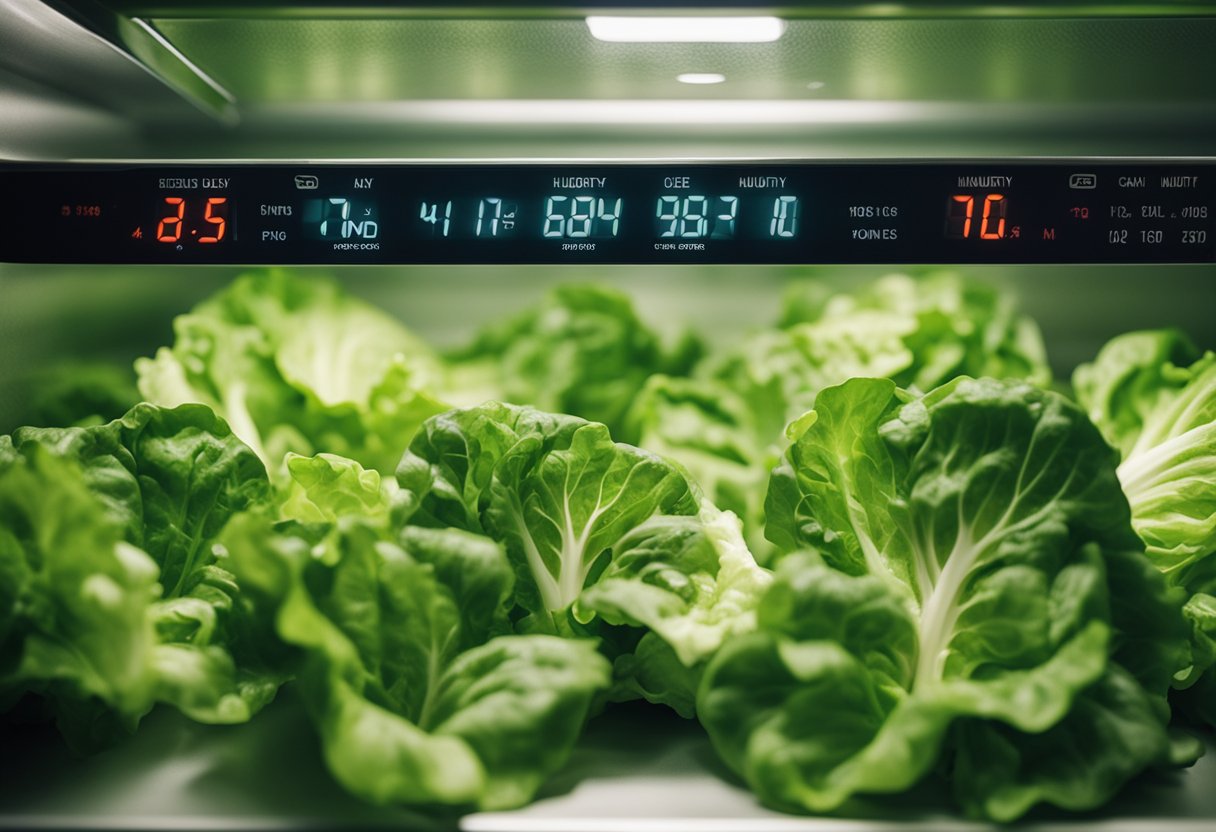
After storing the lettuce, it’s essential to monitor it regularly to ensure that it stays fresh and crisp. Here are some tips to help you spot spoilage and refresh lettuce that has begun to wilt.
Spotting Spoilage
The first sign of spoilage in lettuce is usually discoloration, which can range from brown spots to entire leaves turning brown or black. If you notice any discoloration, it’s best to discard those leaves immediately. Another sign of spoilage is a slimy texture, which can indicate bacterial growth. If you notice any sliminess, discard those leaves as well.
To prevent spoilage, make sure to store the lettuce in a clean and dry container, and avoid overcrowding it. Also, be sure to check the lettuce regularly and remove any leaves that show signs of spoilage.
Refresh Techniques
If you notice that your lettuce is starting to wilt, don’t worry; there are ways to refresh it and extend its shelf life. Here are some techniques to try:
- Soak the lettuce in cold water: Fill a bowl with cold water and submerge the lettuce for a few minutes. This can help to rehydrate the leaves and make them crisp again. After soaking, dry the lettuce thoroughly before storing it.
- Use ice water: If you’re short on time, you can try soaking the lettuce in ice water. This can help to refresh the leaves quickly and make them crisp again.
- Cut off the stem: If you’re storing a head of lettuce, cut off the stem before storing it. This can help to prevent moisture from accumulating at the bottom of the container, which can cause the leaves to wilt.
By monitoring your stored lettuce regularly and using these refresh techniques, you can help to extend its shelf life and ensure that it stays fresh and crisp for as long as possible.
Usage Tips After Storage
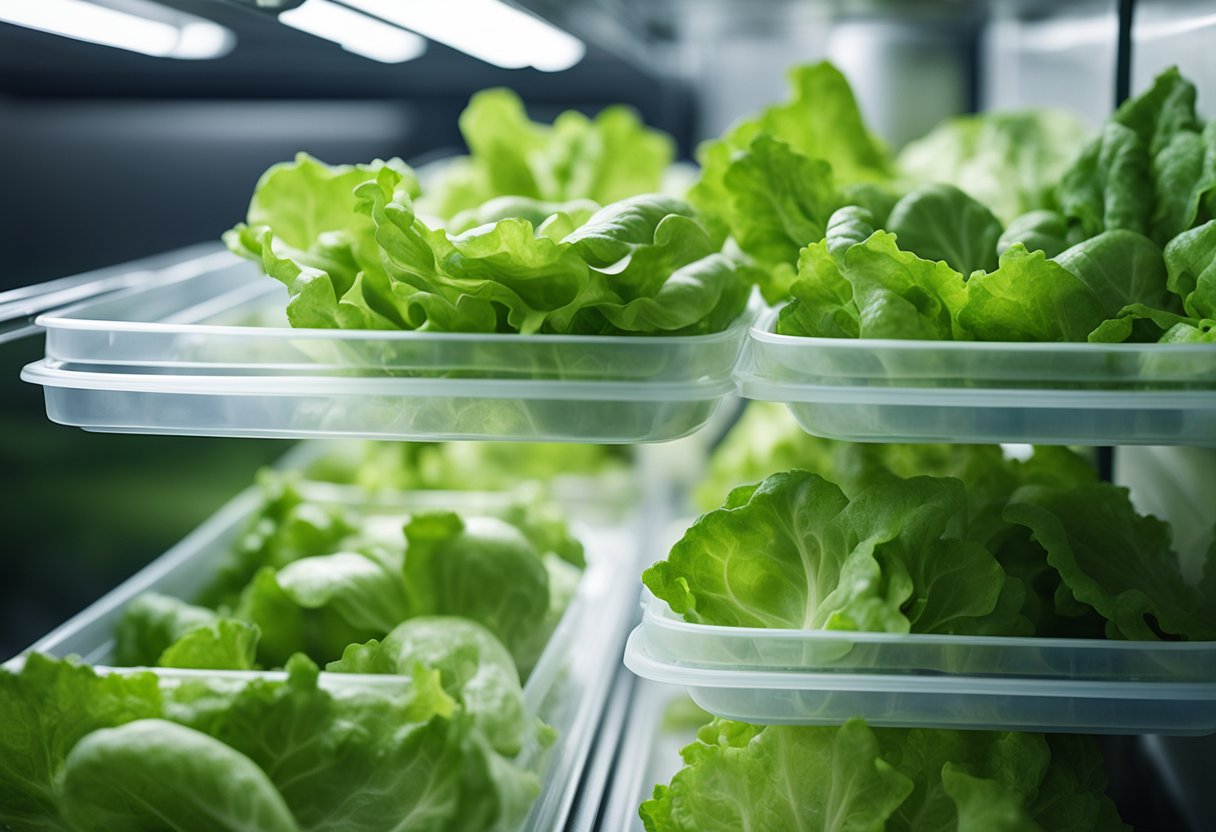
Revitalizing Limp Lettuce
Sometimes, lettuce leaves can become limp after being stored for a few days. However, there are a few simple tricks you can use to revitalize your lettuce and make it crisp again. Here are some of my favorite methods:
- Soak the lettuce leaves in a bowl of cold water for a few minutes. This will help to rehydrate the leaves and make them crisp again.
- Place the lettuce leaves in a plastic bag along with a damp paper towel. Seal the bag and refrigerate for a few hours. The moisture from the paper towel will transfer to the lettuce leaves, making them crisp again.
- Cut the lettuce leaves into bite-sized pieces and place them in a bowl of ice water. Let them soak for a few minutes before draining and drying them. This will help to restore their crispness.
Incorporating into Meals
Once you’ve stored your lettuce leaves properly and revitalized any limp leaves, it’s time to incorporate them into your meals. Here are a few ideas to get you started:
- Make a simple salad by tossing your lettuce leaves with your favorite dressing and toppings. For a more substantial meal, add some protein such as grilled chicken or tofu.
- Use lettuce leaves as a wrap for your sandwiches or tacos. This is a great way to cut down on carbs and add some extra crunch to your meals.
- Add lettuce leaves to your smoothies for an extra boost of nutrients. Baby spinach and kale are great options for green smoothies, while romaine lettuce works well in fruit smoothies.
By following these usage tips, you can ensure that your lettuce leaves stay fresh and crisp, and that you get the most out of your stored lettuce.
FAQs – How to Store Lettuce Leaves
What is the optimal container for maintaining the freshness of lettuce?
When storing lettuce, it is essential to use an airtight container to maintain the freshness of the leaves. The container should be large enough to accommodate the lettuce without crushing it. A plastic bag or airtight container is the best option for storing lettuce.

What are the best practices for keeping lettuce fresh after it’s been cut?
The best way to keep lettuce fresh after it has been cut is to store it in an airtight container or plastic bag in the refrigerator. Make sure to remove any excess moisture from the leaves before storing them. It is also recommended to use a paper towel to absorb any excess moisture and keep the leaves dry.
Can lettuce be kept fresh without refrigeration, and if so, how?
Lettuce is best stored in the refrigerator to maintain its freshness. However, if you do not have access to a refrigerator, you can store lettuce in a cool, dry place. Make sure to keep the leaves dry and away from any direct sunlight.
What steps should be taken to store romaine lettuce in the refrigerator effectively?
To store romaine lettuce effectively, remove any wilted or damaged leaves and rinse the remaining leaves under cold water. Dry the leaves thoroughly and wrap them in a paper towel before placing them in an airtight container or plastic bag. Store the container in the crisper drawer of the refrigerator.
How can one extend the freshness of iceberg lettuce after it’s been cut?
To extend the freshness of iceberg lettuce after it has been cut, store it in an airtight container or plastic bag in the refrigerator. Make sure to remove any excess moisture from the leaves before storing them. It is also recommended to use a paper towel to absorb any excess moisture and keep the leaves dry.
What techniques are there to prevent cut lettuce from browning?
To prevent cut lettuce from browning, you can add a small amount of lemon juice to the container before storing it in the refrigerator. Another option is to store the lettuce with a damp paper towel to keep the leaves moist and prevent them from drying out.